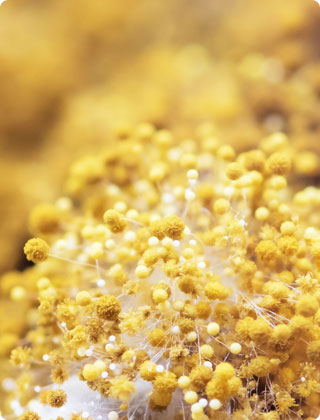Orange Mold: The Definitive Guide to Identification & Removal

If you've spotted patches of orange growing around your shower, basement, or attic, you're not alone. And it's more than just a weird-looking stain. Orange mold isn't as famous as black mold, but it can cause real problems for your home and health if left untreated. Often mistaken for rust or grime, this mold thrives in damp areas, slowly damaging surfaces and confusing homeowners in the process.
This guide from O2 Mold Testing cuts through the confusion. From what orange mold really is to where it hides, how dangerous it might be, and what you can do about it, you'll get clear, science-backed answers. Whether you're staring down a fuzzy patch in your bathroom or noticing stains on wooden beams, here's everything you need to know to fight back - safely and effectively.
Can Mold Be Orange? Understanding the Phenomenon
Yes - mold can absolutely be orange. And if you've spotted it, you're likely dealing with one of several possible culprits. These orange-hued organisms aren't always technically "mold" in the scientific sense, but they share enough traits to raise concern.
Types of Organisms That Appear Orange
True fungi like Aspergillus flavus, which is known to produce cancer-linked aflatoxins, are often mistaken for more harmless varieties. Slime molds, though visually similar, are technically protists rather than fungi. Bacterial colonies such as Serratia marcescens also frequently take on a pinkish-orange hue and can mimic the appearance of mold in bathrooms and kitchens.
Why Color Isn't a Reliable Risk Indicator
Color alone doesn't indicate whether the organism is dangerous. Some orange-colored species are completely harmless, while others can damage materials, produce toxins, or impact indoor air quality.
Where Orange Mold Appears in Homes
Orange mold isn't limited to growing in one particular area of your home. It appears anywhere there's moisture and organic material, making bathrooms, wood structures, and walls all common targets.
Orange Mold in Shower & Bathroom Areas
Bathrooms, with their constant humidity and warmth, often host a mix of bacteria and fungi that create orange slime in showers, around faucets, or under toilet rims. Homeowners frequently find themselves scrubbing only for the growth to return within days. Silicone caulking, tile grout, and plastic shower liners are all common areas of this kind of growth. Unfortunately, most surface cleaners mask the surface color but leave the underlying problem intact.
Orange Mold on Wood Surfaces
Wooden surfaces are another hotspot. Consider attic beams exposed to roof leaks or windowsills that trap condensation. Wooden furniture pressed against damp exterior walls can also develop orange mold. Because wood is porous, orange mold can penetrate deeply, making surface-level cleaning ineffective. Over time, the mold can break down the wood's integrity, leading to soft spots, stains, and even rot.
Orange Mold on Walls
Walls, especially those made of drywall or covered with wallpaper, offer ideal conditions for mold to flourish if there's any water intrusion. A small plumbing leak behind a wall can result in fuzzy or powdery orange mold colonies that remain hidden until discoloration or odors emerge. Wallpaper adhesive often acts as a food source, and once mold takes hold, it spreads quickly under the surface.
Different Kinds of Orange Mold
Not all orange mold looks or behaves the same way. Some species form fuzzy, velvety mats while others develop slick, slime-like masses.
Orange Slime Mold (Myxomycetes)
Slime molds, commonly known as Myxomycetes, often appear outdoors on mulch or rotting wood. These bright orange blobs can sometimes show up inside garages or basements with poor ventilation and organic debris. Strangely enough, slime molds can move slowly over surfaces and often disappear as quickly as they arrive.
Orange Fuzzy Mold
Fuzzy orange mold tends to be what people associate with the term "mold." These colonies often contain species like Aspergillus flavus, Penicillium, or Trichoderma. Aspergillus is notable for its potential to release harmful toxins into the air, while Trichoderma is known to break down building materials. Fuzzy mold often spreads outward in patches and grows well in damp, poorly lit areas. Over time, it can begin to discolor surfaces, trigger allergic reactions, and produce a musty odor that lingers.
Is Orange Mold Dangerous? Health Risks Explained
Orange mold is not inherently dangerous, but some species can cause health problems, especially for sensitive individuals. The main concern lies in prolonged exposure to airborne spores or mycotoxins produced by certain types.
Who's at Risk and Why
People with asthma, allergies, or compromised immune systems are at greater risk of experiencing symptoms like respiratory irritation, sinus congestion, persistent coughing, and fatigue. In more severe cases, neurological symptoms such as brain fog, headaches, and difficulty concentrating may develop.
Different Organisms, Different Risks
The severity of health effects depends on the specific organism, how long someone has been exposed, and their individual sensitivity. While slime molds and many bacterial colonies are not toxic, they can still produce unpleasant odors and harbor other harmful microorganisms. On the other hand, fungi like Aspergillus flavus have been linked to serious long-term health risks, especially in poorly ventilated indoor spaces.
Orange Mold on Food
Food contamination is another major concern. Orange mold on food, particularly citrus fruits, is usually caused by Penicillium digitatum. Although it might be tempting to cut away the moldy part and eat the rest, this can be risky. Mycotoxins can penetrate deep into soft food, making the entire item unsafe. Ingesting these toxins can lead to gastrointestinal distress and, in some cases, long-term health complications.
Removal & Prevention Strategies
Removing orange mold successfully means addressing both the visible growth and the conditions that allowed it to thrive.
Cleaning Mold in Bathrooms
In showers and bathrooms, it's important to go beyond routine cleaning. Start by scrubbing affected areas with hydrogen peroxide, which not only kills mold but also penetrates porous surfaces better than bleach. After rinsing with a baking soda solution to help neutralize odors and deter regrowth, dry all surfaces thoroughly with a fan or microfiber towel. Applying a diluted tea tree oil spray can help create a mold-resistant barrier on caulking and tiles.
Treating Mold on Wood
Wood surfaces require a more cautious approach. Begin by sanding away visible mold growth while wearing protective gear like gloves and an N95 respirator. Once the surface has been cleaned, apply a borax-based solution, which inhibits mold without needing to be rinsed off. After drying completely, the area should be sealed with a mold-resistant primer before refinishing. In cases of severe damage, replacing the affected wood may be necessary.
Dealing With Mold on Walls
For walls, especially drywall, removal often depends on the extent of contamination. Small areas may be cleaned using the same borax or hydrogen peroxide treatment, but larger infestations typically require cutting out and replacing the damaged section. It is also critical to fix any leaks, improve ventilation, and use dehumidifiers if necessary to prevent recurrence.
When to Call Professionals
There are times when professional intervention is not just recommended - it's necessary. If the affected area exceeds ten square feet, mold has returned despite your leaning efforts, or if it's spread into HVAC systems, calling certified mold remediation experts is the safest course of action.
In many cases, it also starts with bringing in mold inspection and testing specialists to get a clear picture of the problem. Professionals like O2 Mold Testing can identify the type of mold, the extent of the contamination, and hidden trouble spots you might miss. Our detailed reports help guide the remediation process and ensure nothing gets overlooked.
When health and safety are on the line, expert help makes all the difference.
Professional Support and Indoor Air Testing
Professionals have the equipment to test the type of mold, contain the spread, and ensure it is completely eliminated without risking cross-contamination. Additionally, if occupants are experiencing unexplained health symptoms that improve when they leave the home, a full mold assessment should be prioritized.
Key Takeaways
Orange mold can range from a harmless annoyance to a serious health hazard, depending on the species and setting. It thrives in moist environments and feeds on organic material, making bathrooms, wood surfaces, and drywall common targets.
The Importance of Expert Orange Mold Detection
While not all orange mold is toxic, any persistent growth should be taken seriously, especially if it's accompanied by odors or health symptoms. Orange mold thrives in moist, organic-rich environments like bathrooms, wooden surfaces, and walls, and can lead to damage over time if left unchecked.
If you suspect orange mold in your home, seek professional help today. O2 Mold Testing is a trusted name when it comes to providing mold testing services. Professional mold testing is crucial to ensuring a safe and healthy living environment. Our certified services offer comprehensive inspections to identify and address mold issues effectively.
Swift and accurate identification of orange mold is our expertise. Whether it's through visual inspection, odor detection, or professional testing, we've got you covered. Understanding the nature of your mold problem is key to making the right decisions, and trusting us ensures you get the best guidance.


